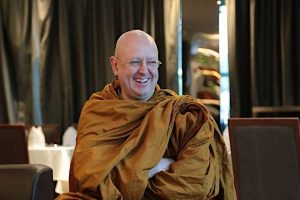
The Fourth Noble Truth is The Path that leads to the cessation of dukkha (“ill-being” or “suffering”). The Path is also called the Noble Eightfold Path of Right View, Right Thinking, Right Speech, Right Action, Right Livelihood, Right Effort, Right Mindfulness, and Right Concentration. Whole books have been written about the Noble Eightfold Path, and a single article cannot hope to explore the topic in any depth. There is value, however, in looking at this Truth as a whole.
Without even knowing much about the Noble Eightfold Path, the simple statement The Path that leads to the cessation of dukkha implies that suffering can be overcome. Liberation is not only for the rich and powerful, not granted by the grace of God, and not something that existed only long ago for a people far away. Liberation is available to everyone. Contemplating this, my Christian roots want to call out “Hallelujah!” It is a praiseworthy revelation indeed.
The next aspect that stands out for me about the Eightfold Path is that generally speaking, the points are very ordinary. Thinking, Speaking, Acting, gaining one’s Livelihood, Mindfulness, Concentration, View, and Effort are what make up everyone’s lives. Awakening is cultivated in our daily lives, not just through esoteric rituals. Great teachers and specific practices can certainly help, but this path cannot be divorced from the daily realities of eating and working and caring for one’s family. We don’t have to wait for a certain set of conditions to arise to cultivate this path; our lives themselves are the very path of awakening.
Another important factor for putting the Fourth Noble Truth into practice in life is understanding samma, which is usually translated as “right,” as in Right View, Right Thinking, and so on. There are many translations and interpretations for samma, including “wise,” “connected,” and “just.” The one that resonates most for me is “upright,” as in Upright View, Upright Thinking, Upright Speech, Upright Action, Upright Livelihood, Upright Effort, Upright Mindfulness, and Upright Concentration. Keeping with the usual translation of “right” makes it very easy for the mind to fixate on judging right from wrong, as if there was only one way to do things and all else must be judged as wrong. This isn’t the point of samma. Integrity, or uprightness, is much more the point of the Buddha’s teachings. When our lives are less than wholesome, we become easily trapped in doubt, suspicion, and fear—mental freedom is not possible when plagued by such mental formations. Leading a virtuous life frees the mind from hatred and fear, which is why we cultivate an ethical life. Rather than fixating on what is right, we can continually find ways to be upright in our thoughts, actions, and interactions. It will look a little different for everyone, but you know it when you feel it. Upright.
My teacher, Thich Nhat Hanh, sometimes taught us to look at the Four Noble Truths in a different order, starting with well-being—“There is well-being and a path that leads to well-being. There is ill-being and a path that leads to ill-being.” This adaptation really opened my heart earlier on in my practice. It felt light and joyful. Now I have come to see that there is deep wisdom in the original order in that it begins with suffering. It is too easy to try to ignore suffering and to jump straight to well-being. If dukkha wasn’t at the beginning, we would all just try to skip it. Looking into dukkha must be part of the path in order to realize cessation, or a deep and lasting peace. Why is this so important? Skipping the exploration of suffering is like trying to treat an illness without knowing its cause. An antibiotic can cure a cough caused by bacteria but it cannot help emphysema or lung cancer. Similarly, looking for happiness is bound to fail most of the time. The Buddha, in his great compassion, wanted to help us and so taught about suffering in order to teach us to transform it.
The Four Noble Truths inform one another. They are more of an ongoing spiral of understanding and action than a trajectory of A-B-C-D. When one has tasted the ease that comes from the freedom of a liberated mind, then cultivating the Path is something that one runs toward. It is not an obligation. One shouldn’t force oneself onto this path or get stuck in beliefs. Rather, one should allow one’s joy, one’s true joy, to inspire one onward. This is how the Fourth Noble Truth can also be called The Path of Joy. May your own path be joyful.
See more
Is Life Suffering? The Four Noble Truths in Daily Life: Part One
I Want What I Want When I Want It! The Four Noble Truths in Daily Life: Part Two
A Little Liberation Can Go a Long Way—The Four Noble Truths in Daily Life: Part Three













